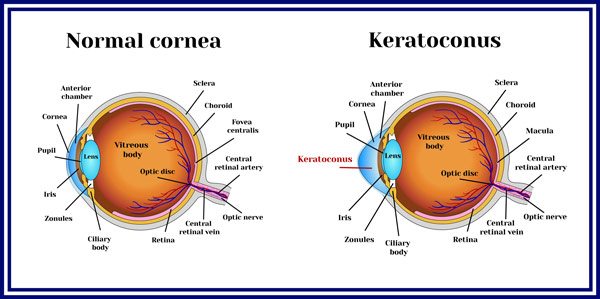Experience clearer vision with advanced keratoconus care, including corneal cross-linking and INTACS implants. Serving San Luis Obispo, Paso Robles, and Santa Maria, these proven treatments help slow progression and improve vision at every stage of the condition.
Keratoconus is a progressive eye disease in which the normally round cornea thins and begins to bulge into a cone-like shape. This distortion affects how light enters the eye and can lead to significant vision problems. If left untreated, keratoconus can result in severe visual impairment and may require surgical intervention.

The exact cause of keratoconus is still under research, but most experts believe it results from a combination of genetic, environmental, and hormonal factors. It typically begins during the teenage years and may progress into the 30s or 40s.
In rare cases, keratoconus can develop after refractive surgeries such as LASIK, in which case it is referred to as post-LASIK ectasia.
Keratoconus affects approximately 1 in 500 to 1 in 2,000 people worldwide. Early diagnosis is essential to managing progression and preserving vision.
Symptoms may develop slowly over years or progress rapidly, and include:
In advanced stages, keratoconus can result in severe vision loss and scarring of the cornea.
Treatment depends on the severity and rate of progression of the disease. The goal is to stabilize the cornea and improve vision.
Corneal Collagen Cross-Linking is a minimally invasive procedure that strengthens corneal tissue and helps halt the progression of keratoconus. It works by applying riboflavin drops followed by UV light to increase collagen bonds in the cornea.
INTACS are FDA-approved, crescent-shaped plastic inserts surgically placed in the cornea to improve its shape and reduce nearsightedness and astigmatism.
You may be eligible for INTACS if you:
Performed at our San Luis Obispo eye center, INTACS surgery is a quick outpatient procedure lasting 10–20 minutes:
After surgery:
Our board-certified ophthalmologists offer leading-edge diagnostics and treatment for keratoconus in San Luis Obispo, Paso Robles, and Santa Maria. We specialize in early intervention, corneal cross-linking, and advanced surgical options like INTACS and corneal transplants.
If you’ve been diagnosed with keratoconus or are experiencing distorted vision, we encourage you to schedule an evaluation with one of our corneal specialists. Early treatment can preserve your sight and help you avoid future complications.
ADV Vision has offices in San Luis Obispo, Paso Robles, and Santa Maria, California, as well as Surgery Center in San Luis Obispo.